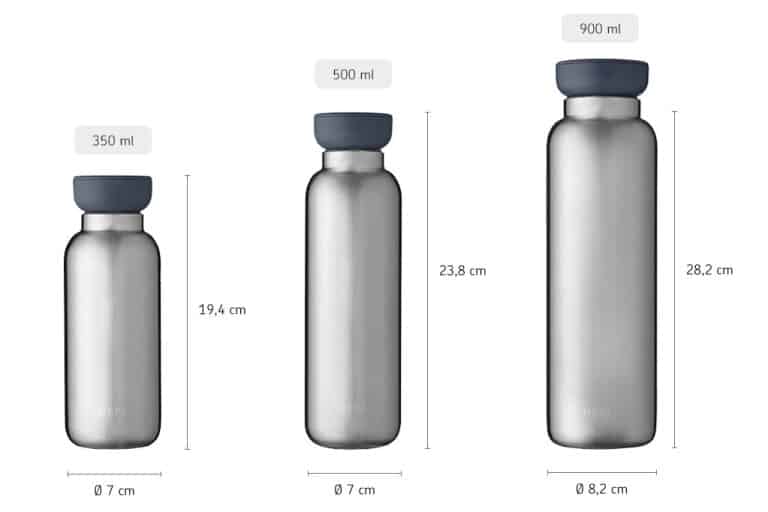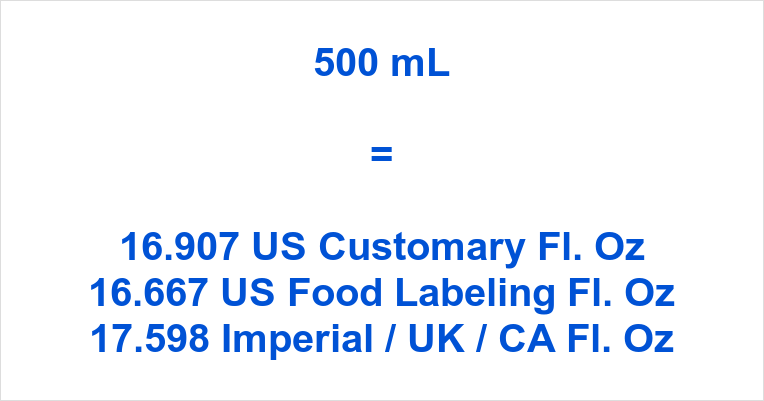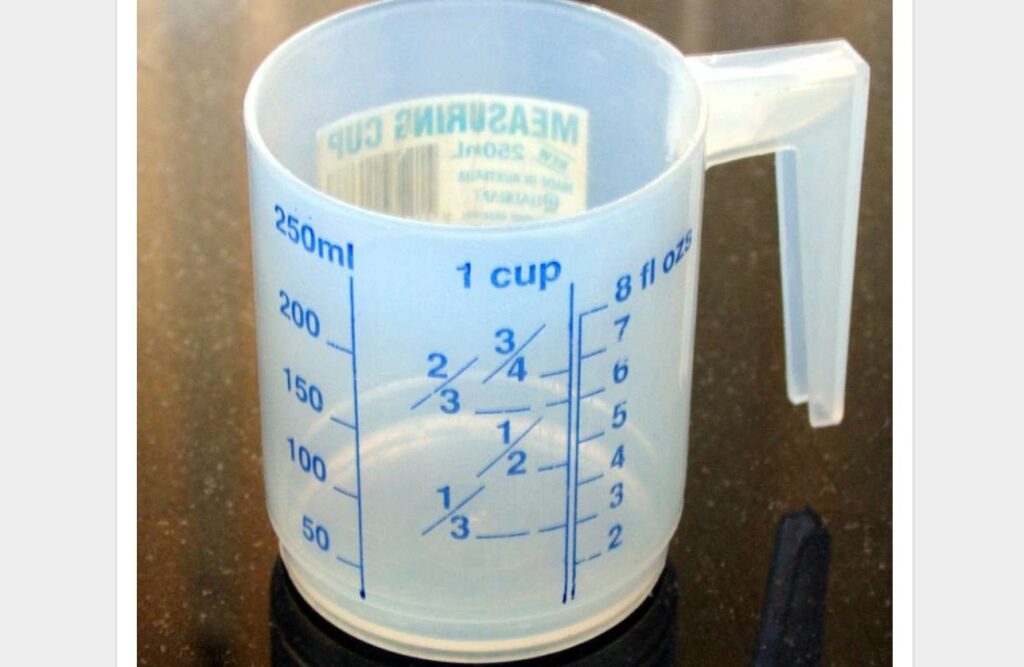In this article, we embark on a journey to unravel the mystery behind the conversion of 500ml to oz. While it may seem like a straightforward calculation, delving deeper uncovers the nuances of fluid volume and the historical significance of measurement units.
Accurate communication becomes paramount in a world where information travels across borders and cultures. This is especially true when it comes to measurements, whether you’re a home cook following a recipe, a traveller deciphering labels in a foreign land, or simply curious about the intricacies of unit conversion.
Understanding the relationship between different measurement systems is essential. One such conversion that often raises questions is the transition from millilitres (ml) to fluid ounces (oz).

Join us as we explore the science, history, and practicality of converting millilitres to fluid ounces, demystifying a common conversion that holds relevance in both our daily lives and global interactions.
Whether you’re a math enthusiast, a curious learner, or someone seeking clarity in the realm of measurements, this exploration promises to shed light on the relationship between 500 ml and fluid ounces, ultimately enhancing your understanding of the interconnected world of measurement systems.
Read Also: How Many Pints in a Quart? (Liquid Measurement)
Definition of Milliliters and Ounces: 500ML to OZ
Millilitres (ml): Milliliters are a metric unit of volume commonly used in the International System of Units (SI). A millilitre is equal to one-thousandth of a litre, which is the base unit of volume in the metric system. It is often used to measure small quantities of liquids, such as water, milk, or cooking ingredients.
Fluid Ounces (oz): Fluid ounces are a unit of volume measurement commonly used in the United States and a few other countries. Unlike the dry ounce, which is used to measure weight, the fluid ounce is used to measure volume.
It is often used to measure beverages, cooking oils, and sauces. The fluid ounce is slightly different from the standard (avoirdupois) ounce, with variations in its conversion between different measurement systems.
Read Also: How Many Steps in a Mile
Milliliters to Ounces Conversion
The conversion from millilitres (ml) to fluid ounces (oz) is not always straightforward due to the differences in measurement systems. In general, 1 fluid ounce (US) is approximately equal to 29.5735 millilitres. However, for simplicity, you can use the approximate conversion factor of 1 ml being roughly equivalent to 0.0338 fluid ounces.

To convert 500 millilitres to fluid ounces, you can use either of the conversion factors mentioned above:
- Using the approximate conversion factor (1 ml ≈ 0.0338 oz): 500 ml × 0.0338 ≈ 16.9 fluid ounces
- Using the more precise conversion factor (1 fluid oz (US) = 29.5735 ml): 500 ml ÷ 29.5735 ≈ 16.91 fluid ounces
Please note that the above conversions are approximate due to rounding. Additionally, the conversion factors may vary slightly if you are converting between different fluid ounce definitions (US, UK, etc.).
Related Article: How Many Cups in a Litre? Quick Conversion Guide
Importance of Conversions
Conversions play a crucial role in various aspects of our lives, contributing to effective communication, commerce, science, and everyday activities. Here are some key reasons why conversions are important:
1. Global Communication
Conversions enable effective communication across different countries, cultures, and languages. With the world being a global village, accurate conversions ensure that information is understood universally, whether it’s measurements, currency, or units of time.
2. International Trade
In international trade, accurate conversions are vital for pricing, shipping, and compliance with regulations. Converting currencies, weights, volumes, and dimensions ensures that products and services can be traded seamlessly across borders.
3. Scientific Research
Accurate conversions are essential for maintaining precision and consistency in experiments and studies. Incorrect conversions can lead to inaccurate results and hinder the progress of scientific knowledge.
4. Cooking and Baking
Conversions are crucial in the kitchen, ensuring that recipes can be followed accurately. Converting ingredients, temperatures, and measurements from one system to another guarantees that dishes turn out as expected.
5. Travel and Navigation
When travelling to different countries, conversions help travellers understand distances, temperatures, and currency values. Navigation tools often require conversions to provide accurate directions and estimates.
6. Health and Medication
In healthcare, accurate conversions are essential for administering medications, calculating dosages, and interpreting medical measurements. Incorrect conversions can have serious consequences for patients.
7. Engineering and Construction
In engineering and construction, accurate conversions are essential for designing structures, determining dimensions, and selecting appropriate materials. Mistakes in conversions can lead to structural flaws.
8. Education and Learning
Schools teach conversions to help students understand different measurement systems and enhance their problem-solving skills. Learning conversions fosters a deeper understanding of mathematics and units of measurement.
9. Conservation and Sustainability
Conversions are relevant in fields like energy consumption, where understanding measurements in different units helps individuals and industries make informed decisions to conserve resources and promote sustainability.
10. Personal Life
Conversions are also important in personal life, whether it’s converting units for home improvement projects, budgeting for purchases, or planning travel itineraries.
Conversions facilitate accurate and effective communication, enable informed decision-making, and ensure that systems, industries, and individuals can operate seamlessly in a diverse and interconnected world.
Read Also: How many Quarts in a Gallon (Food Measurements)
500 ML to OZ: Importance of Accurate Conversions
Accurate conversions are of paramount importance in various aspects of daily life, ranging from commerce and science to travel and education.
The significance of accurate conversions lies in their ability to ensure precision, consistency, and effective communication across different measurement systems. Here are some key reasons why accurate conversions are essential:
1. Precision in Science and Engineering
Accuracy is crucial for obtaining reliable results and designing safe and efficient systems in scientific research and engineering. Accurate conversions of measurements and units contribute to the validity of experiments, calculations, and technical designs.
2. Reliable and International Trade
In global trade, accurate conversions are vital for pricing products, calculating shipping costs, and complying with international standards. Mistakes in conversions can lead to financial losses and hinder the smooth flow of goods and services.
3. Safe Healthcare Practices
In the medical field, accurate conversions are critical for administering medications at the correct dosages, interpreting medical test results, and ensuring patient safety. Incorrect conversions can have serious implications for patient health.
4. Consistency in Communication
Accurate conversions facilitate clear and consistent communication between individuals, organizations, and countries. Whether it’s sharing data, measurements, or specifications, accurate conversions prevent misunderstandings and errors.
5. Effective Educational Learning
Accurate conversions are taught in schools to enhance mathematical skills and promote a deeper understanding of various measurement systems. They lay the foundation for analytical thinking and problem-solving abilities.
6. Reliable Construction and Design
Accurate conversions are essential for creating structures that meet safety standards and functional requirements in architecture and construction. Precision in measurements and units ensures that buildings and infrastructure are well-designed and stable.
7. Seamless Travel and Navigation
Accurate conversions are crucial for navigation systems, ensuring that travellers receive accurate directions, distances, and estimated travel times. This enhances travel efficiency and reduces the likelihood of getting lost.
8. Conserving Resources
Accurate conversions are important for managing resources effectively. Whether it’s energy consumption, waste management, or environmental monitoring, accurate measurements support sustainable practices.
9. Culinary Success
Accurate conversions of ingredients and measurements are essential for achieving consistent and delicious results in cooking and baking. Precision in conversions ensures that recipes can be replicated successfully.
10. Data Integrity
Accurate conversions maintain the integrity of data when information is transferred between different systems, databases, or platforms. This is crucial in maintaining accurate records and analysis.
In essence, accurate conversions underpin various activities that contribute to safety, efficiency, innovation, and effective communication in our interconnected world. They bridge the gap between different measurement systems, ensuring that information is understood and applied correctly across diverse contexts.
Related Article: How Many Bottles of Water is a Gallon?
500 ML to OZ: The Conversion Formula
The conversion formula for converting millilitres (ml) to fluid ounces (oz) depends on your specific conversion factor. Here are the two commonly used conversion factors:

1. Approximate Conversion Factor: Using the approximate conversion factor of 1 ml ≈ 0.0338 oz, the formula to convert millilitres to fluid ounces is:
Fluid Ounces (oz) = Milliliters (ml) × 0.0338
For example, to convert 500 ml to fluid ounces: Fluid Ounces (oz) = 500 ml × 0.0338 ≈ 16.9 oz
2. More Precise Conversion Factor: Using the more precise conversion factor of 1 fluid ounce (US) = 29.5735 ml, the formula to convert millilitres to fluid ounces is:
Fluid Ounces (oz) = Milliliters (ml) ÷ 29.5735
For example, to convert 500 ml to fluid ounces: Fluid Ounces (oz) = 500 ml ÷ 29.5735 ≈ 16.91 oz
Keep in mind that these formulas provide approximate values due to rounding. The conversion factor you choose depends on the precision level you require for your calculations.
Practical Examples
Here are some practical examples of converting millilitres (ml) to fluid ounces (oz) using both the approximate and more precise conversion factors:
Example 1: Using Approximate Conversion Factor (1 ml ≈ 0.0338 oz)
Problem: Convert 250 ml to fluid ounces.
Solution: Fluid Ounces (oz) = 250 ml × 0.0338 Fluid Ounces (oz) ≈ 8.45 oz
Example 2: Using a More Precise Conversion Factor (1 fluid oz (US) = 29.5735 ml)
Problem: Convert 750 ml to fluid ounces.
Solution: Fluid Ounces (oz) = 750 ml ÷ 29.5735 Fluid Ounces (oz) ≈ 25.36 oz
Example 3: Using Approximate Conversion Factor (1 ml ≈ 0.0338 oz)
Problem: Convert 1000 ml to fluid ounces.
Solution: Fluid Ounces (oz) = 1000 ml × 0.0338 Fluid Ounces (oz) ≈ 33.8 oz
Example 4: Using More Precise Conversion Factor (1 fluid oz (US) = 29.5735 ml)
Problem: Convert 1500 ml to fluid ounces.
Solution: Fluid Ounces (oz) = 1500 ml ÷ 29.5735 Fluid Ounces (oz) ≈ 50.72 oz
Using both conversion factors, these examples demonstrate how to convert millilitres to fluid ounces. Depending on the level of accuracy required for your specific context, you can choose either the approximate or more precise conversion factor to perform the conversion.
Read Also: How Many Cups in a Pound
Common Conversion Mistakes to Avoid
Converting measurements, such as millilitres to fluid ounces, is common, but it’s important to be aware of potential pitfalls that can lead to conversion mistakes. Here are some common conversion mistakes to avoid:
1. Using the Wrong Conversion Factor
Using an incorrect conversion factor is a common mistake. Make sure you’re using the appropriate factor for the specific conversion you’re performing, whether it’s millilitres to fluid ounces, inches to centimetres, or any other unit conversion.
2. Rounding Too Early
Rounding during intermediate steps of a calculation can lead to inaccurate results. Perform calculations using the full precision of the conversion factor before rounding to the desired number of decimal places.
3. Mixing Up Measurement Systems
Different countries use different measurement systems, such as the metric and imperial systems. Mixing up units from different systems can lead to errors. Always ensure that you’re using consistent units in your conversions.
4. Not Checking Units in Equations
When performing calculations, it’s crucial to check that units are consistent on both sides of the equation. Make sure the units match and cancel out correctly to ensure accurate results.
5. Not Using Parentheses
When performing complex calculations involving multiple operations, it’s important to use parentheses to ensure the correct order of operations. Failing to do so can lead to incorrect results.
6. Ignoring Significant Figures
If you’re working with measurements with specific significant figures, carry these through your calculations and final result. Rounding to the appropriate number of significant figures is important for maintaining accuracy.
7. Forgetting Conversion Prefixes
In the metric system, prefixes like kilo-, centi-, and milli- indicate orders of magnitude. Neglecting to include these prefixes in your conversion factor can lead to errors of 10 or 100 times.
8. Not Checking Your Work
After performing a conversion, take a moment to verify that your result makes sense. Does the converted value align with your expectations and the context of the problem?
9. Using Approximations Improperly
While approximate conversion factors are useful for quick estimations, they should not be used for precise calculations or scientific work. Reserve them for cases where a rough estimate is sufficient.
10. Copying Errors
Transferring numbers from one step of a calculation to another can lead to copying errors. Double-check your work to ensure that numbers are entered correctly in each step.
By being mindful of these common mistakes and practising careful calculation techniques, you can perform accurate conversions and avoid errors that might otherwise compromise the integrity of your results.
Read Also: How Many Teaspoons Are in a Tablespoon
Tools for Converting 500 ML TO OZ
Converting measurements accurately can be made easier and more convenient with the help of various tools and resources. Here are some tools that can assist you in performing easy and accurate conversions:

1. Online Conversion Calculators
Numerous websites offer online conversion calculators that allow you to quickly convert between different units of measurement. Simply enter the value you want to convert and select the units, and the calculator will provide you with the converted result.
2. Mobile Apps
Several mobile apps are available for both iOS and Android devices that offer unit conversion functionalities. These apps often cover a wide range of units and provide a user-friendly interface for easy conversions on the go.
3. Unit Conversion Tables
Print or digital unit conversion tables provide a quick reference for common conversions. These tables list conversions for various units, making finding the conversion factor you need easy.
4. Built-in Calculator Apps
Most standard calculator apps on smartphones and computers have built-in unit conversion features. These calculators allow you to perform calculations and conversions in a single application.
5. Voice-Activated Assistants
Voice-activated virtual assistants like Siri, Google Assistant, and Alexa can perform unit conversions for you. Simply ask the assistant to convert a specific value from one unit to another.
6. Scientific Calculators
Scientific calculators often come with unit conversion functions that allow you to convert measurements quickly. These calculators are particularly useful for students, professionals, and those working with complex calculations.
7. Physical Conversion Cards
Some educational or reference materials provide physical conversion cards that you can carry with you for quick conversions. These cards can be especially handy when you don’t have access to digital tools.
8. Browser Extensions
Certain browser extensions can add unit conversion capabilities to your web browser. These extensions can automatically convert measurements on web pages as you browse.
9. Spreadsheet Software
Spreadsheet software like Microsoft Excel and Google Sheets can be used to create custom conversion tables and perform calculations. You can set up formulas to convert measurements within the spreadsheet.
10. Programmable Calculators
Advanced programmable calculators allow you to create custom conversion programs that can handle various units and provide accurate results.
Whether you’re a student, a professional, or someone who occasionally needs to convert units, these tools can simplify the conversion process and ensure that you obtain accurate results quickly and efficiently.
Related Article: How Many Square Feet in an Acre: How to Calculate the Size
Conclusion
In the world of measurements, conversions stand as a bridge connecting diverse systems and contexts. From fluid ounces to millilitres, inches to centimetres, or currencies from around the world, accurate conversions are essential for clear communication, effective trade, scientific accuracy, and practical everyday tasks.
Embracing the significance of conversions empowers us to navigate the global landscape with precision and confidence. It ensures that we can confidently interpret international recipes, make informed purchases while travelling, create accurate scientific experiments, and communicate seamlessly with individuals from different backgrounds.
As we conclude our exploration of conversions, let us appreciate the role these conversions play in simplifying our lives and fostering a deeper understanding of the interconnected world.
Frequently asked questions on 500ml to OZ
How many fluid ounces are in 500 milliliters?
There are approximately 16.91 fluid ounces in 500 milliliters.
How do I convert 500 milliliters to fluid ounces?
To convert milliliters to fluid ounces, you can use the conversion factor: 1 milliliter is approximately equal to 0.033814 fluid ounces. So, for 500 milliliters, you can multiply 500 by 0.033814 to get the equivalent in fluid ounces.
Is 500 milliliters more or less than 16 ounces?
500 milliliters is slightly more than 16 ounces. To be more precise, 500 milliliters is approximately equal to 16.91 fluid ounces.
Are milliliters and cubic centimeters the same thing?
Milliliters (ml) and cubic centimeters (cm³) are equivalent measurements. They both represent the same volume of liquid or substance. One milliliter is equal to one cubic centimeter.
Why are fluid ounces used in some countries while milliliters are used in others?
Different countries and regions use different units of measurement based on their historical and cultural preferences. In the United States, fluid ounces are commonly used for measuring liquids, while milliliters are more commonly used in countries that use the metric system, such as most of Europe.
